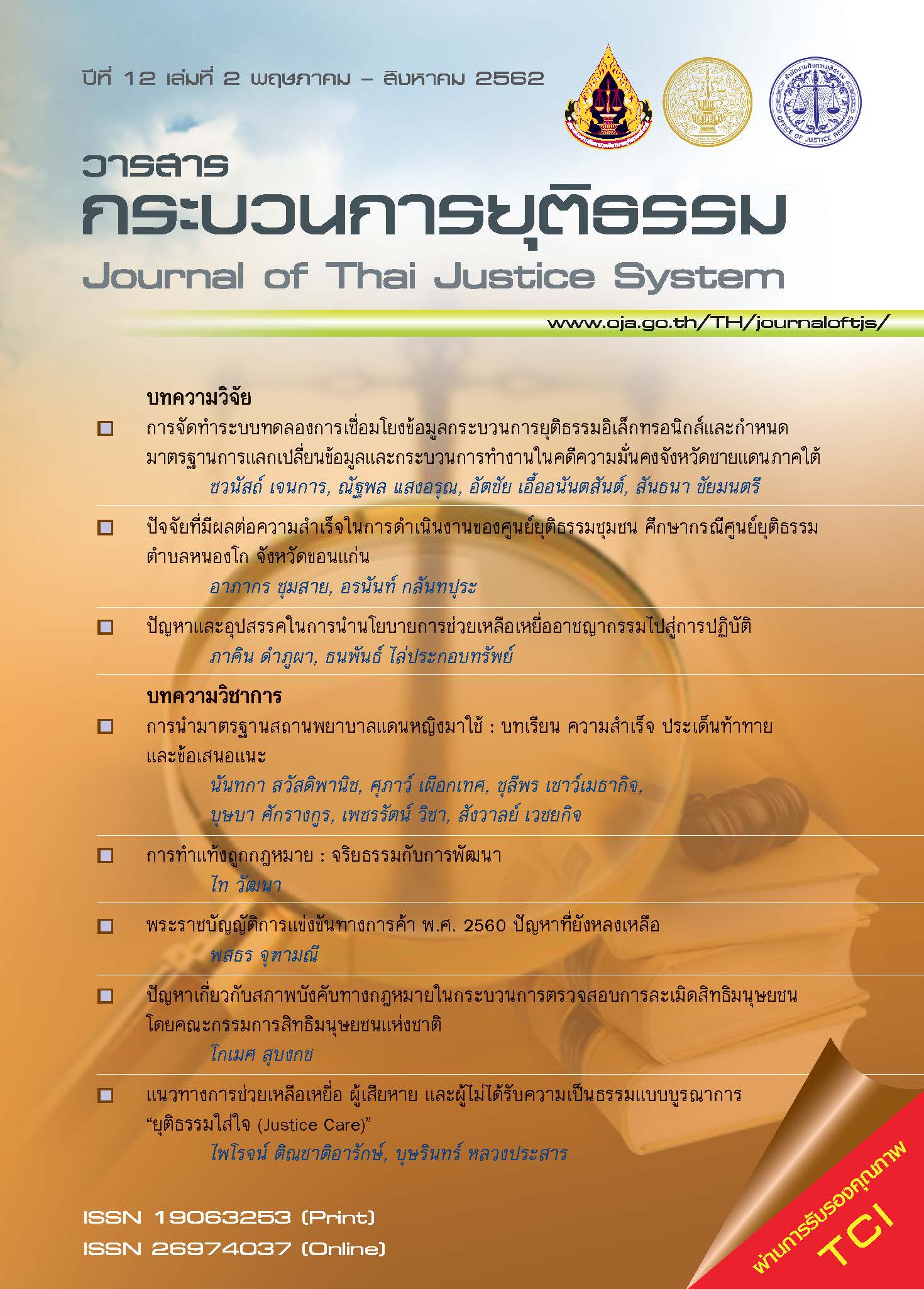ปัญหาและอุปสรรคในการนำนโยบายการช่วยเหลือเหยื่ออาชญากรรมไปสู่การปฏิบัติ
Main Article Content
บทคัดย่อ
บทความนี้มีจุดมุ่งหมายเพื่อ (1) ศึกษาปัญหาและอุปสรรคในการนำนโยบายการช่วยเหลือเหยื่ออาชญากรรมไปสู่การปฏิบัติและ (2) เสนอแนะแนวทางในการนำนโยบายในการช่วยเหลือเหยื่ออาชญากรรมไปสู่การปฏิบัติในอนาคต ซึ่งเป็นการวิจัยเชิงคุณภาพโดยการวิจัยเอกสารที่เกี่ยวข้องกับการนำนโยบายไปสู่การปฏิบัติและนโยบายการช่วยเหลือเหยื่ออาชญากรรมและการสัมภาษณ์เชิงลึกผู้ให้ข้อมูลสำคัญ องค์กรภาครัฐ และองค์กรพัฒนาเอกชนผลการศึกษาวิจัยพบว่า เนื้อหาสาระของนโยบายมีวัตถุประสงค์ยังไม่ชัดเจน เนื่องจากมีกฎหมายหลายฉบับเข้ามาเกี่ยวข้องวัสดุอุปกรณ์เครื่องมือเครื่องใช้ยังมีไม่เพียงพอในการปฏิบัติงานบุคลากรมีไม่เพียงพอกับคำขอรับค่าตอบแทนที่มีเป็นจำนวนมากทั่วประเทศ พนักงานคุ้มครองสิทธิและเสรีภาพ นิติกร มีขวัญกำลังใจและสวัสดิการในการปฏิบัติงานน้อย เนื่องจากนิติกรส่วนใหญ่เป็นพนักงานจ้างเหมาบริการ นิติกรมีตัวชี้วัดการทำคำขอรับค่าตอบแทน 21 วัน การมีหน่วยงานที่เกี่ยวข้องจำนวนมากส่งผลให้การปฏิบัติงานมีความล่าช้าในการปฏิบัติงานควรมีกฎหมายที่ครอบคลุมกฎหมายที่เกี่ยวข้องในการช่วยเหลือเหยื่ออาชญากรรมทั้งหมด โดยให้มีสำนักงานคุ้มครองผู้เสียหายในคดีอาญาโดยเฉพาะ เพิ่มงบประมาณในการจัดซื้อวัสดุอุปกรณ์เครื่องมือเครื่องใช้ในการปฏิบัติงาน มีการรับสมัครและคัดเลือกนิติกรเข้าปฏิบัติงานในจังหวัดเพิ่มมากขึ้น เพิ่มขวัญกำลังใจในการปฏิบัติงานให้กับนิติกร และจ้างนิติกรในลักษณะของลูกจ้างชั่วคราวแทนการจ้างแบบพนักงานจ้างเหมาบริการ เพื่อให้สามารถใช้สิทธิประกันสังคมได้ มีการใช้เทคโนโลยีสารสนเทศเข้ามาช่วยอำนวยความสะดวกในการประสานงานขอข้อมูลกับหน่วยงานอื่น ลดจุดในการตัดสินใจในการปฏิบัติงานให้น้อยลง เพิ่มอนุกรรมการให้ครอบคลุมทุกจังหวัด และเพิ่มรอบในการประชุมในแต่ละเดือนอย่างน้อย 3ครั้งต่อเดือน และภาครัฐควรส่งเสริมให้องค์กรพัฒนาเอกชนเข้ามามีส่วนร่วมในการช่วยเหลือเหยื่ออาชญากรรมมากขึ้น
Article Details
ต้นฉบับที่ได้รับการตีพิมพ์ในวารสาร เป็นลิขสิทธิ์ของวารสารกระบวนการยุติธรรม แต่ความคิดเห็นที่ปรากฏในเนื้อหาของบทความในวารสารกระบวนการยุติธรรม ถือเป็นความรับผิดชอบของผู้เขียนแต่เพียงผู้เดียว
เอกสารอ้างอิง
ธนพันธ์ ไล่ประกอบทรัพย์ และคณะ.(2560). การสร้างความเป็นธรรมทางสังคมผ่านนโยบายสวัสดิการสังคม: กรณีศึกษาการเข้าถึงและได้รับประโยชน์จากโครงการเบี้ยยังชีพผู้สูงอายุ. วารสารผู้ตรวจการแผ่นดิน, 10 (1), 50-79.
สำนักงานช่วยเหลือทางการเงินแก่ผู้เสียหายและจำเลยในคดีอาญา. (2562). พระราชบัญญัติค่าตอบแทนผู้เสียหาย และค่าทดแทนและค่าใช้จ่ายแก่จำเลยในคดีอาญา พ.ศ. 2544 และแก้ไขเพิ่มเติม (ฉบับที่ 2) พ.ศ. 2559.ค้นจาก http://www.rlpd.go.th/rlpdnew/2012-11-19-05-41-15
หนังสือต่างประเทศ
Edwards. (1980). Implementing Public Policy.Washington, D.C.: Congressional Quarterly Press.
Mazmanian& Sabatier. (1983). Implementation and Public Policy.Ilinois: ScottForesman.
Pressman &Wildavsky. (1973). Implementation. Berkley, California: University of California Press.
Van Meter & Van Horn. (1975). The Policy Implementation Process: A Conceptual Framework. Administration and Society,6(4), 445-488.


